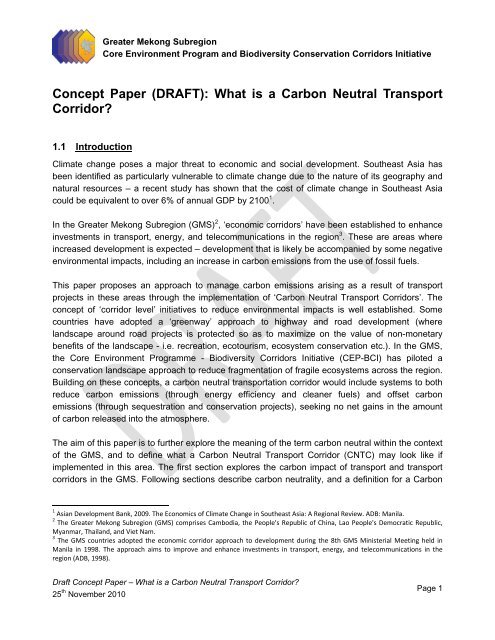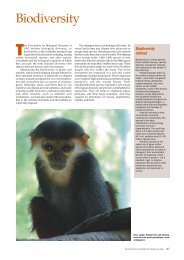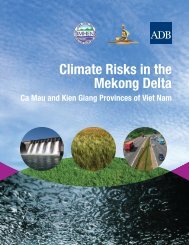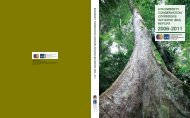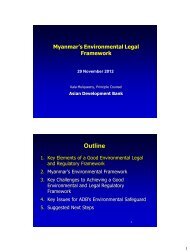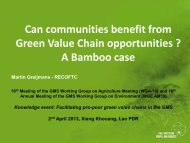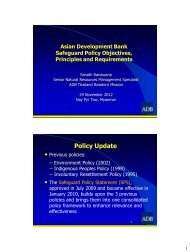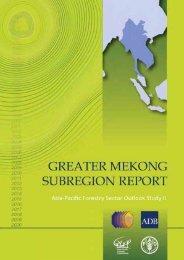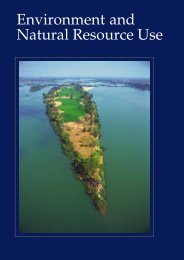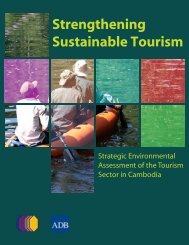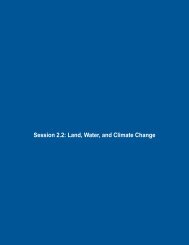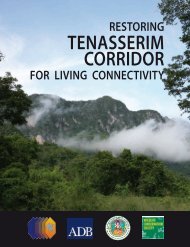What is a Carbon Neutral Transport Corridor? - Greater Mekong ...
What is a Carbon Neutral Transport Corridor? - Greater Mekong ...
What is a Carbon Neutral Transport Corridor? - Greater Mekong ...
You also want an ePaper? Increase the reach of your titles
YUMPU automatically turns print PDFs into web optimized ePapers that Google loves.
<strong>Greater</strong> <strong>Mekong</strong> Subregion<br />
Core Environment Program and Biodiversity Conservation <strong>Corridor</strong>s Initiative<br />
Concept Paper (DRAFT): <strong>What</strong> <strong>is</strong> a <strong>Carbon</strong> <strong>Neutral</strong> <strong>Transport</strong><br />
<strong>Corridor</strong>?<br />
1.1 Introduction<br />
Climate change poses a major threat to economic and social development. Southeast Asia has<br />
been identified as particularly vulnerable to climate change due to the nature of its geography and<br />
natural resources – a recent study has shown that the cost of climate change in Southeast Asia<br />
could be equivalent to over 6% of annual GDP by 2100 1 .<br />
In the <strong>Greater</strong> <strong>Mekong</strong> Subregion (GMS) 2 , ‘economic corridors’ have been establ<strong>is</strong>hed to enhance<br />
investments in transport, energy, and telecommunications in the region 3 . These are areas where<br />
increased development <strong>is</strong> expected – development that <strong>is</strong> likely be accompanied by some negative<br />
environmental impacts, including an increase in carbon em<strong>is</strong>sions from the use of fossil fuels.<br />
Th<strong>is</strong> paper proposes an approach to manage carbon em<strong>is</strong>sions ar<strong>is</strong>ing as a result of transport<br />
projects in these areas through the implementation of ‘<strong>Carbon</strong> <strong>Neutral</strong> <strong>Transport</strong> <strong>Corridor</strong>s’. The<br />
concept of ‘corridor level’ initiatives to reduce environmental impacts <strong>is</strong> well establ<strong>is</strong>hed. Some<br />
countries have adopted a ‘greenway’ approach to highway and road development (where<br />
landscape around road projects <strong>is</strong> protected so as to maximize on the value of non-monetary<br />
benefits of the landscape - i.e. recreation, ecotour<strong>is</strong>m, ecosystem conservation etc.). In the GMS,<br />
the Core Environment Programme - Biodiversity <strong>Corridor</strong>s Initiative (CEP-BCI) has piloted a<br />
conservation landscape approach to reduce fragmentation of fragile ecosystems across the region.<br />
Building on these concepts, a carbon neutral transportation corridor would include systems to both<br />
reduce carbon em<strong>is</strong>sions (through energy efficiency and cleaner fuels) and offset carbon<br />
em<strong>is</strong>sions (through sequestration and conservation projects), seeking no net gains in the amount<br />
of carbon released into the atmosphere.<br />
The aim of th<strong>is</strong> paper <strong>is</strong> to further explore the meaning of the term carbon neutral within the context<br />
of the GMS, and to define what a <strong>Carbon</strong> <strong>Neutral</strong> <strong>Transport</strong> <strong>Corridor</strong> (CNTC) may look like if<br />
implemented in th<strong>is</strong> area. The first section explores the carbon impact of transport and transport<br />
corridors in the GMS. Following sections describe carbon neutrality, and a definition for a <strong>Carbon</strong><br />
1 Asian Development Bank, 2009. The Economics of Climate Change in Southeast Asia: A Regional Review. ADB: Manila.<br />
2 The <strong>Greater</strong> <strong>Mekong</strong> Subregion (GMS) compr<strong>is</strong>es Cambodia, the People's Republic of China, Lao People's Democratic Republic,<br />
Myanmar, Thailand, and Viet Nam.<br />
3 The GMS countries adopted the economic corridor approach to development during the 8th GMS Min<strong>is</strong>terial Meeting held in<br />
Manila in 1998. The approach aims to improve and enhance investments in transport, energy, and telecommunications in the<br />
region (ADB, 1998).<br />
Draft Concept Paper – <strong>What</strong> <strong>is</strong> a <strong>Carbon</strong> <strong>Neutral</strong> <strong>Transport</strong> <strong>Corridor</strong>?<br />
25 th November 2010<br />
Page 1
<strong>Greater</strong> <strong>Mekong</strong> Subregion<br />
Core Environment Program and Biodiversity Conservation <strong>Corridor</strong>s Initiative<br />
<strong>Neutral</strong> <strong>Transport</strong> <strong>Corridor</strong> <strong>is</strong> proposed. Finally, some initiatives and policies are suggested as<br />
possible ways to develop a CNTC.<br />
1.2 <strong>Transport</strong> corridors and carbon em<strong>is</strong>sions in the GMS<br />
It <strong>is</strong> widely accepted that transport <strong>is</strong> one of the main drivers for the increase in greenhouse gas<br />
em<strong>is</strong>sions and a changing global climate. Globally, transport was responsible for 13% of<br />
greenhouse gas em<strong>is</strong>sions (GHGs) in 2006 4 . Across the GMS countries, average transport related<br />
GHGs have been seen to be lower than the global average 5 (see Figure 1). However, various<br />
forecasts of future trends show that within South and Southeast Asia transport related em<strong>is</strong>sions<br />
will see a three to five fold increase by 2030 (if no new policies are introduced to tackle these<br />
em<strong>is</strong>sions), making Asia responsible for 31% of global transport em<strong>is</strong>sions by 2030 6 . Th<strong>is</strong> increase<br />
in transport em<strong>is</strong>sions has been attributed mainly to increasing numbers of light duty vehicles<br />
(passenger cars and smaller road freight vehicles) and heavy goods vehicles (larger road freight<br />
vehicles).<br />
40.0<br />
35.0<br />
30.0<br />
25.0<br />
20.0<br />
15.0<br />
10.0<br />
5.0<br />
0.0<br />
GHGs from transport as a percentage of overall GHGs<br />
in 2001<br />
Viet Nam Myanmar Thailand China* GMS<br />
average<br />
Source: World Resources Institute, 2005<br />
*Th<strong>is</strong> <strong>is</strong> the total for the People’s Republic of China as a whole.<br />
Global<br />
average<br />
Figure 1: Greenhouse<br />
gas em<strong>is</strong>sions from the<br />
transportation sector in<br />
the GMS<br />
The initial focus of the economic corridors within the GMS program has been on improving road<br />
4 International Energy Agency, 2008. World Energy Outlook 2008. IEA: Par<strong>is</strong>.<br />
5 Th<strong>is</strong> figure <strong>is</strong> based on 1994 data and excludes Lao PDR and Myanmar due to a lack of d<strong>is</strong>aggregated GHG data (UNSTAT, 2009).<br />
6 Schipper, L., Fabian, H., and Leather, J., 2009. <strong>Transport</strong> and <strong>Carbon</strong> Dioxide Em<strong>is</strong>sions: Forecasts, Options Analys<strong>is</strong>, and<br />
Evaluation. ADB Sustainable Development Working Paper Series. ADB: Manila.<br />
Draft Concept Paper – <strong>What</strong> <strong>is</strong> a <strong>Carbon</strong> <strong>Neutral</strong> <strong>Transport</strong> <strong>Corridor</strong>?<br />
25 th November 2010<br />
Page 2
<strong>Greater</strong> <strong>Mekong</strong> Subregion<br />
Core Environment Program and Biodiversity Conservation <strong>Corridor</strong>s Initiative<br />
links along certain routes so as to create continuous land access connecting the main development<br />
hubs in the region. Each of the GMS transport corridors, therefore, includes a number of road and<br />
highway development projects to upgrade and consolidate the continuous land routes.<br />
An CEP-BCI prefeasibility study of one of the transport corridors being establ<strong>is</strong>hed across<br />
Myanmar, Thailand, Lao PDR and Viet Nam (GMS East West Economic <strong>Corridor</strong>) shows that<br />
em<strong>is</strong>sions from transport are estimated to be in the order of 1 million tonnes per year, of which just<br />
over half <strong>is</strong> attributable to freight traffic 7 . Th<strong>is</strong> <strong>is</strong> a significant amount and <strong>is</strong> equivalent to 0.6% of<br />
Thailand’s, 2.1% of Vietnam’s and 14% of Myanmar’s annual em<strong>is</strong>sions in 2001. The CEP-BCI<br />
study found that in order to sequester these em<strong>is</strong>sions 150,000 ha of land would be required.<br />
The estimate for the East West Economic <strong>Corridor</strong> (EWEC) takes into account only the direct<br />
em<strong>is</strong>sions ar<strong>is</strong>ing from traffic, and not the em<strong>is</strong>sions that would ar<strong>is</strong>e as a result of the<br />
development that would accompany better transport links in the area (changes to land use, more<br />
industry and production in the area, deforestation etc.) nor the em<strong>is</strong>sions ar<strong>is</strong>ing from construction<br />
activity. Factoring in these potential em<strong>is</strong>sions sources could increase the forecast em<strong>is</strong>sions from<br />
the corridor significantly 8 .<br />
The overall carbon em<strong>is</strong>sions and related impacts of these transportation corridors are likely to be<br />
considerable. There <strong>is</strong> a need for initiatives to address these.<br />
1.3 <strong>What</strong> <strong>is</strong> a <strong>Carbon</strong> <strong>Neutral</strong> project?<br />
The UN defines climate neutrality as ‘a way of living’ that produces zero net greenhouse gas<br />
em<strong>is</strong>sions. UN (2008) specifies that climate neutrality can be achieved by first reducing em<strong>is</strong>sions<br />
resulting from an activity and then offsetting any residual em<strong>is</strong>sions. An extension of the climate<br />
or carbon neutral concept <strong>is</strong> that of ‘carbon neutral infrastructure’ or ‘zero carbon infrastructure’,<br />
where energy efficiency measures are used to reduce the em<strong>is</strong>sions from an infrastructure project,<br />
and remaining energy demand <strong>is</strong> met using renewable energy.<br />
The main weakness of the carbon neutral approach <strong>is</strong> that by including offsetting in the definition,<br />
responsibility for em<strong>is</strong>sions can be d<strong>is</strong>placed and there <strong>is</strong> a r<strong>is</strong>k that a project achieves its carbon<br />
neutral status without reducing any em<strong>is</strong>sions overall. Also, due to the complexity in the nature of<br />
carbon accounting, and uncertainty in data collection, current projects around the world that aim to<br />
achieve ‘carbon neutral’ status only take into account the em<strong>is</strong>sions resulting as a direct result of<br />
the operations of the infrastructure i.e. em<strong>is</strong>sions ar<strong>is</strong>ing due to the use of fossil fuels ‘on site’. The<br />
7 Fraser, A., Linde, L., Kityuttachai, K and Tantasirin, C., 2007. Report on a preliminary assessment of the scope for implementing a<br />
<strong>Carbon</strong> <strong>Neutral</strong> <strong>Transport</strong> <strong>Corridor</strong> in the GMS. Environment Operations Center: Bangkok.<br />
8 For example, a recent study of the carbon impacts across a selected portfolio of ADB funded transport projects highlighted that<br />
carbon em<strong>is</strong>sions from construction activity can vary between 1% and 24% of the construction and operational em<strong>is</strong>sions for a<br />
project. (Asian Development Bank, 2010. Reducing <strong>Carbon</strong> Em<strong>is</strong>sions from <strong>Transport</strong> Projects. ADB: Manila.).<br />
Draft Concept Paper – <strong>What</strong> <strong>is</strong> a <strong>Carbon</strong> <strong>Neutral</strong> <strong>Transport</strong> <strong>Corridor</strong>?<br />
25 th November 2010<br />
Page 3
<strong>Greater</strong> <strong>Mekong</strong> Subregion<br />
Core Environment Program and Biodiversity Conservation <strong>Corridor</strong>s Initiative<br />
considerable em<strong>is</strong>sions ‘embodied’ in the construction or demolition of such infrastructure or the<br />
em<strong>is</strong>sions that may ar<strong>is</strong>e as an indirect result of the project (e.g. fewer em<strong>is</strong>sions being<br />
sequestered due to deforestation) are rarely considered.<br />
In order to tackle GHGs ar<strong>is</strong>ing from regional initiatives in the GMS, where GHG reduction targets<br />
are not mandatory as yet, a more hol<strong>is</strong>tic approach to carbon neutral projects <strong>is</strong> required. Any such<br />
approach should set clear carbon reduction and offset targets at the outset in order to insure both<br />
elements of the carbon neutral concept are considered.<br />
1.4 Defining the boundaries of carbon neutral transport infrastructure<br />
In order to propose the boundaries and salient features of a <strong>Carbon</strong> <strong>Neutral</strong> <strong>Transport</strong> <strong>Corridor</strong> in<br />
the GMS, it <strong>is</strong> necessary to understand the various sources of em<strong>is</strong>sions that could ar<strong>is</strong>e as a<br />
result of a transport corridor and where the potential carbon savings could be achieved.<br />
For the purposes of th<strong>is</strong> paper, a theoretical transport infrastructure project <strong>is</strong> considered based<br />
loosely on the East West Economic <strong>Corridor</strong> (EWEC) being establ<strong>is</strong>hed across Myanmar,<br />
Thailand, Lao PDR and Viet Nam which cons<strong>is</strong>ts of a number of transport projects being<br />
implemented in different areas to create a unified ‘transport corridor’. The simplified life cycle of<br />
each project would be as follows: the project’s life would begin at the stage where the concept of<br />
the project was first developed and the technical design for the project was completed. The next<br />
stages in the life-cycle would include construction and use of the road transport infrastructure.<br />
Finally, the road and related infrastructure would be upgraded or replaced with newer or different<br />
infrastructure.<br />
An estimate of ‘whole life’ carbon for the infrastructure would need to consider GHGs emitted as a<br />
direct result of the road project at each of the different stages of the life-cycle. However, some of<br />
which may be resource intensive to measure and may not be significant over the lifetime of the<br />
project. Further, apart from the direct em<strong>is</strong>sions associated with the life cycle of the road<br />
infrastructure project, the induced em<strong>is</strong>sions ar<strong>is</strong>ing as a result of the outcomes of a road project<br />
(i.e. better connectivity) should not be d<strong>is</strong>counted. These could vary from increased em<strong>is</strong>sions from<br />
the development that will accompany better transport links and access in the area to increased<br />
em<strong>is</strong>sions attributable to future investments that may occur in the region as a result of better<br />
transport and trade connectivity.<br />
Accounting for and measuring all the various sources of carbon that may be emitted as a result of<br />
one project <strong>is</strong> beyond the scope of th<strong>is</strong> approach, and in reality, may not be necessary. For the<br />
GMS, it <strong>is</strong> important to consider all the significant sources of em<strong>is</strong>sions within the boundaries of a<br />
<strong>Carbon</strong> <strong>Neutral</strong> <strong>Transport</strong> <strong>Corridor</strong> and to understand which areas should be targeted in order to<br />
achieve the greatest reduction in carbon em<strong>is</strong>sions. Table 1 l<strong>is</strong>ts some of the main sources of<br />
Draft Concept Paper – <strong>What</strong> <strong>is</strong> a <strong>Carbon</strong> <strong>Neutral</strong> <strong>Transport</strong> <strong>Corridor</strong>?<br />
25 th November 2010<br />
Page 4
<strong>Greater</strong> <strong>Mekong</strong> Subregion<br />
Core Environment Program and Biodiversity Conservation <strong>Corridor</strong>s Initiative<br />
direct and induced GHGs at each stage in the life-cycle of a road transport project and highlights<br />
the difference in the magnitude of these em<strong>is</strong>sions.<br />
Table 1: Sources of greenhouses gases throughout the life-cycle of a transport infrastructure project<br />
Key:<br />
Least significant<br />
Likely to be between<br />
1% and 15% of<br />
overall em<strong>is</strong>sions<br />
Most significant<br />
Likely to be 15% to<br />
90% of overall<br />
em<strong>is</strong>sions<br />
Stages in the life<br />
of a road project<br />
Activity / impact<br />
Sources of GHGs<br />
Directly as a result of the project<br />
Indirect outcome of project<br />
Concept and<br />
design of<br />
road project<br />
Development of<br />
project concept<br />
Technical detailed<br />
design of project<br />
• Fuel used in office space<br />
• Fuel used in business travel<br />
Time<br />
Construction<br />
Use of road<br />
infrastructure<br />
Construction<br />
activity to build /<br />
upgrade road<br />
transport<br />
infrastructure<br />
Increased traffic<br />
movement and<br />
increased<br />
development due<br />
to better transport<br />
links.<br />
Forest clearance<br />
and agriculture<br />
land conversion<br />
as a result of road<br />
development.<br />
• Fuel used to extract, process<br />
and transport construction<br />
materials<br />
• 'Process' em<strong>is</strong>sions produced<br />
during the manufacture of<br />
construction materials (e.g. CO 2<br />
release during cement<br />
manufacture)<br />
• Fuel used to operate machinery<br />
used during construction<br />
• Fuel used to run passenger<br />
and freight vehicles along the<br />
corridor (only from additional<br />
traffic plying corridors as a<br />
result of the project)<br />
• Fuel used in development<br />
/ industry initiated due to<br />
project (only new industry<br />
developed as a result of<br />
the corridor)<br />
• Decrease in GHGs<br />
sequestered due to<br />
reduction in forest area as<br />
a result of the project<br />
• GHG em<strong>is</strong>sions ar<strong>is</strong>ing<br />
from land use change<br />
Draft Concept Paper – <strong>What</strong> <strong>is</strong> a <strong>Carbon</strong> <strong>Neutral</strong> <strong>Transport</strong> <strong>Corridor</strong>?<br />
25 th November 2010<br />
Page 5
<strong>Greater</strong> <strong>Mekong</strong> Subregion<br />
Core Environment Program and Biodiversity Conservation <strong>Corridor</strong>s Initiative<br />
Maintenance<br />
/ replacement<br />
Maintenance of<br />
new / upgraded<br />
infrastructure<br />
• Fuel used to extract, process<br />
and transport construction<br />
materials<br />
• 'Process' em<strong>is</strong>sions produced<br />
during the manufacture of<br />
construction materials (i.e. CO 2<br />
release during cement<br />
manufacture)<br />
• Fuel used to operate machinery<br />
used during construction<br />
Sources of Information: ADB (2010) 9 ; Fraser et al. (2007) 10 ; Switalski (2005) 11<br />
The l<strong>is</strong>t of em<strong>is</strong>sions sources given in Table 1 <strong>is</strong> not exhaustive, nor <strong>is</strong> the assessment of the likely<br />
significance of em<strong>is</strong>sions based on robust bottom-up data for the region. However, the table does<br />
serve to highlight the major sources of em<strong>is</strong>sions that are likely to ar<strong>is</strong>e as a result of a road<br />
transport infrastructure project and where the main initial focus of a ‘<strong>Carbon</strong> <strong>Neutral</strong> <strong>Transport</strong><br />
<strong>Corridor</strong>’ project should be. Such an initiative should (if practicable) focus on the following sources<br />
of increased em<strong>is</strong>sions 12 :<br />
1. Em<strong>is</strong>sions from increasing traffic along the corridor (both passenger and freight)<br />
2. Em<strong>is</strong>sions from the development of industry / production along the corridor<br />
3. <strong>Carbon</strong> debit resulting from deforestation and land use change in the area<br />
1.5 Developing a <strong>Carbon</strong> <strong>Neutral</strong> <strong>Transport</strong> <strong>Corridor</strong><br />
The UN recommends a five step approach to achieve climate neutrality – measure, act, reduce,<br />
offset and evaluate 13 . Though all these are important, reduce and offset are the two areas of<br />
activity that will result in the most em<strong>is</strong>sions reductions and should be prioritized when developing<br />
initiatives to tackle em<strong>is</strong>sions from a GMS transport corridor. Within th<strong>is</strong> context, th<strong>is</strong> paper<br />
proposes a definition for a GMS <strong>Carbon</strong> <strong>Neutral</strong> <strong>Transport</strong> <strong>Corridor</strong>:<br />
A <strong>Carbon</strong> <strong>Neutral</strong> <strong>Transport</strong> <strong>Corridor</strong> <strong>is</strong> an area surrounding a transport network that realizes<br />
net zero greenhouse gas em<strong>is</strong>sions through a parallel process of reducing em<strong>is</strong>sions through<br />
9 Asian Development Bank, 2010. Reducing <strong>Carbon</strong> Em<strong>is</strong>sions from <strong>Transport</strong> Projects. ADB: Manila.<br />
10 Fraser, A., Linde, L., Kityuttachai, K and Tantasirin, C., 2007. Report on a preliminary assessment of the scope for implementing a<br />
<strong>Carbon</strong> <strong>Neutral</strong> <strong>Transport</strong> <strong>Corridor</strong> in the GMS. Environment Operations Center: Bangkok.<br />
11 Switalski, A., 2005. The Ecological Effects of Roads in the Brazilian Amazon: Current Status and Prospects for the Future. Road‐<br />
RIPorter, Volume 10:3. http://www.wildlandscpr.org/road‐riporter/autumn‐equinox‐2005‐volume‐10‐3 . Accessed on 07.10.10.<br />
12 Em<strong>is</strong>sions from construction activity, and particularly from the use of imported construction materials or those that have been<br />
transported long d<strong>is</strong>tances, are also important across transport projects in general, but may not be in the case of road upgrade<br />
projects as are currently included in the GMS transport corridors. As demonstrated by ADB (2010), these em<strong>is</strong>sions are often<br />
greater in projects involving elevated structures or tunnels which typically require large volumes of concrete, steel and excavation.<br />
13<br />
United Nations, 2008. Kick the habit – the UN Guide to Climate <strong>Neutral</strong>ity. GRID‐Arendal: Norway.<br />
Draft Concept Paper – <strong>What</strong> <strong>is</strong> a <strong>Carbon</strong> <strong>Neutral</strong> <strong>Transport</strong> <strong>Corridor</strong>?<br />
25 th November 2010<br />
Page 6
<strong>Greater</strong> <strong>Mekong</strong> Subregion<br />
Core Environment Program and Biodiversity Conservation <strong>Corridor</strong>s Initiative<br />
the support of more efficient processes and management, and sequestration of unavoidable,<br />
remaining em<strong>is</strong>sions through the protection and enhancement of forest ecosystems.<br />
As d<strong>is</strong>cussed in UN (2008), it <strong>is</strong> essential to understand the baseline conditions and the scale of<br />
em<strong>is</strong>sions expected over the lifetime of the transport corridor in order to develop effective initiatives<br />
to reduce GHGs. Measurement and analys<strong>is</strong> of the magnitude of these em<strong>is</strong>sions, i.e. a detailed<br />
feasibility study, <strong>is</strong> expected to be the first step in the development of a <strong>Carbon</strong> <strong>Neutral</strong> <strong>Transport</strong><br />
<strong>Corridor</strong>.<br />
In order to further scope the initiatives that could be used to reduce and offset em<strong>is</strong>sions in order to<br />
achieve a <strong>Carbon</strong> <strong>Neutral</strong> <strong>Transport</strong> <strong>Corridor</strong>; the following sections consider a selection of f<strong>is</strong>cal<br />
and other policy measures.<br />
1.5.1 <strong>Carbon</strong> <strong>Neutral</strong> <strong>Transport</strong> <strong>Corridor</strong> - Reduce<br />
The main aim of establ<strong>is</strong>hing an economic corridor <strong>is</strong> to increase trade and connectivity, with the<br />
larger goals of increased economic development and reduced poverty in the region 14 . In order to<br />
reduce em<strong>is</strong>sions from such a corridor, therefore, there <strong>is</strong> a need to focus on mitigating or<br />
improving expected carbon em<strong>is</strong>sions, rather than trying to reduce the source of such em<strong>is</strong>sions<br />
i.e. increased development.<br />
• Measures to reduce GHG em<strong>is</strong>sions from increased traffic<br />
There are a number of strategies being adopted across the world to reduce the carbon impact of<br />
transport. These include measures to introduce better traffic management with the aim of<br />
influencing more fuel efficient driver behaviour, encouraging better management of freight<br />
operations (e.g. minim<strong>is</strong>ing empty freight truck movements through better coordination among<br />
companies), replacement / upgrade of freight fleets and encouraging the uptake of more fuel<br />
efficient passenger vehicles. A selection of strategies that could be applied to a GMS <strong>Carbon</strong><br />
<strong>Neutral</strong> <strong>Transport</strong> <strong>Corridor</strong> includes (but <strong>is</strong> not limited to) the following:<br />
Strategy<br />
How could th<strong>is</strong> be implemented<br />
<strong>Corridor</strong> traffic management<br />
(e.g. congestion<br />
management, speed<br />
management, traffic flow<br />
smoothening etc.)<br />
• Initial pilot to demonstrate / test out effectiveness of approaches<br />
followed by capacity building in national traffic / transport<br />
departments<br />
14 Asian Development Bank, 1998. Proceedings of the Eighth Min<strong>is</strong>terial Conference on Subregional Cooperation. ADB: Manila.<br />
Draft Concept Paper – <strong>What</strong> <strong>is</strong> a <strong>Carbon</strong> <strong>Neutral</strong> <strong>Transport</strong> <strong>Corridor</strong>?<br />
25 th November 2010<br />
Page 7
<strong>Greater</strong> <strong>Mekong</strong> Subregion<br />
Core Environment Program and Biodiversity Conservation <strong>Corridor</strong>s Initiative<br />
Log<strong>is</strong>tics management i.e.<br />
initiatives to increase<br />
efficiency of freight<br />
operations<br />
• Adoption of voluntary / mandatory target by freight industry,<br />
alongside capacity building in log<strong>is</strong>tics management to increase<br />
efficiency<br />
Regular road maintenance • Capacity building in national traffic / transport departments<br />
Freight fleet modern<strong>is</strong>ation<br />
and upgrade<br />
Deployment of alternative<br />
fuels in the region<br />
Incentiv<strong>is</strong>e increased fuel<br />
efficiency across passenger<br />
fleets<br />
• F<strong>is</strong>cal policy e.g. incentives to reduce energy use, subsidies /<br />
grants for fleet modern<strong>is</strong>ation and adoption of cleaner<br />
technologies<br />
• National policy / strategy to increase energy generated from<br />
renewable sources<br />
• F<strong>is</strong>cal policy e.g. carbon tax for more polluting vehicles<br />
• National leg<strong>is</strong>lation e.g. introduction of a fuel economy standard<br />
/ em<strong>is</strong>sions standard for new vehicles<br />
It <strong>is</strong> worth noting that national level measures like increasing the modal shift towards more carbon<br />
efficient transport (e.g. rail) have not been included here due to the road based nature of the<br />
economic corridors in the GMS. However, these strategies have been seen to be very effective in<br />
reducing national transport em<strong>is</strong>sions and are being considered elsewhere in the GMS program.<br />
Of the policies shown above, many have been found to be efficient in reducing carbon em<strong>is</strong>sions.<br />
ADB (2010) estimates that traffic management techniques can cut up to 20% of expected traffic<br />
em<strong>is</strong>sions, and that better road maintenance would yield significant carbon and energy savings.<br />
Vehicle scrappage (i.e. a scheme that incentiv<strong>is</strong>es the replacement of older, less efficient vehicles<br />
in a fleet) has been seen to have important co-benefits in that it reduces the em<strong>is</strong>sions of other air<br />
pollutants like particulates, nitrous oxide and sulphur dioxide 15 .<br />
Targeting the reduction of greenhouse gas em<strong>is</strong>sions needs to be seen in the larger context of<br />
environmental and health <strong>is</strong>sues in the GMS. It <strong>is</strong> generally acknowledged that policies to reduce<br />
greenhouse gas em<strong>is</strong>sions are likely to reduce air pollutant em<strong>is</strong>sions and vice versa, though the<br />
extent of th<strong>is</strong> will vary with the specific policy in question. Air pollution <strong>is</strong> a major source of concern<br />
in the GMS and the rest of Asia, with many Asian cities reported as failing to meet WHO air quality<br />
standards and 6.8 million people affected in the region 16 . In order to maxim<strong>is</strong>e the benefits of<br />
initiatives in a <strong>Carbon</strong> <strong>Neutral</strong> <strong>Transport</strong> <strong>Corridor</strong> for GMS countries, th<strong>is</strong> report proposes that the<br />
15 Center of Clean Air Policy, 2005. <strong>Transport</strong>ation Em<strong>is</strong>sions Guidebook: Land Use, Transit & <strong>Transport</strong>ation Demand Management.<br />
www.ccap.org/safe/guidebook/guide_complete.html. Accessed on 6.10.10.<br />
16 Asian Development Bank, 2003. Reducing Vehicle Em<strong>is</strong>sions in Asia. ADB: Manila.<br />
Draft Concept Paper – <strong>What</strong> <strong>is</strong> a <strong>Carbon</strong> <strong>Neutral</strong> <strong>Transport</strong> <strong>Corridor</strong>?<br />
25 th November 2010<br />
Page 8
<strong>Greater</strong> <strong>Mekong</strong> Subregion<br />
Core Environment Program and Biodiversity Conservation <strong>Corridor</strong>s Initiative<br />
choice of policy instruments should priorit<strong>is</strong>e those that have an impact on both air pollutant and<br />
carbon em<strong>is</strong>sions.<br />
• Measures to reduce GHG em<strong>is</strong>sions from development and production<br />
Initiatives to mitigate em<strong>is</strong>sions from expected development in the region, including those from<br />
changes to current land-use, would need to support more efficient supply chains for industry and<br />
production and identify areas where changes to processes could help reduce costs and add value.<br />
One possible strategy to implement th<strong>is</strong> would be to conduct a value chain analys<strong>is</strong> to optim<strong>is</strong>e<br />
ex<strong>is</strong>ting production chains in the area with the aim of decreasing energy use and transport<br />
movements. Th<strong>is</strong> could be implemented through an initial pilot to demonstrate the impact of the<br />
intervention on traffic and em<strong>is</strong>sions in the corridor.<br />
1.5.2 <strong>Carbon</strong> <strong>Neutral</strong> <strong>Transport</strong> <strong>Corridor</strong> - Offset<br />
Due to the ex<strong>is</strong>tence of widespread natural forest in the region, natural carbon sequestration<br />
projects are a logical way to offset em<strong>is</strong>sions from transport and development in the <strong>Carbon</strong><br />
<strong>Neutral</strong> <strong>Transport</strong> <strong>Corridor</strong>. The CEP-BCI study conducted in 2007 estimated that for the EWEC,<br />
50,000 ha of plantations would be required to offset carbon em<strong>is</strong>sions from current traffic and<br />
around 150,000 ha to sequester the likely em<strong>is</strong>sions in 2015, if no other policy were in place to<br />
tackle em<strong>is</strong>sions. However, the amount of carbon that could be offset would depend on the<br />
suitability of land adjacent to the corridors for reforestation and on the type of vegetation that would<br />
be used in sequestration projects.<br />
The actual amount of land required <strong>is</strong> likely to be larger than initially estimated if one considers the<br />
deforestation that <strong>is</strong> likely to take place as a result of increased transport connectivity and overall<br />
development. Many of the GMS countries have conservation and forest protection leg<strong>is</strong>lation in<br />
place already and, in line with the definition proposed in th<strong>is</strong> paper, a CNTC approach should also<br />
focus on strengthening the implementation of current leg<strong>is</strong>lation in order to reduce forest clearance<br />
activities ar<strong>is</strong>ing due to the development of a transport corridor.<br />
As a result, a combined approach of strengthening current policy, introducing policies to protect<br />
overall ex<strong>is</strong>ting forest resources and the implementation of new plantation projects in suitable<br />
areas would be necessary to protect and enhance carbon stocks.<br />
Some possible policy measures to reduce deforestation are as below:<br />
Draft Concept Paper – <strong>What</strong> <strong>is</strong> a <strong>Carbon</strong> <strong>Neutral</strong> <strong>Transport</strong> <strong>Corridor</strong>?<br />
25 th November 2010<br />
Page 9
<strong>Greater</strong> <strong>Mekong</strong> Subregion<br />
Core Environment Program and Biodiversity Conservation <strong>Corridor</strong>s Initiative<br />
Strategy<br />
Strengthen implementation of<br />
forest protection<br />
How could th<strong>is</strong> be implemented<br />
• Capacity building at national, provincial and local levels,<br />
improvement of implementation framework<br />
Increase protected areas • Provincial / national leg<strong>is</strong>lation<br />
Incentivize local protection of<br />
forest area<br />
Promotion of Sustainable<br />
Forest Management (SFM)<br />
• Positive f<strong>is</strong>cal instruments e.g. Payment for Ecosystem Services<br />
• Provincial / national policy alongside extensive capacity building<br />
and guidance development about SFM<br />
1.6 How <strong>is</strong> implementing a <strong>Carbon</strong> <strong>Neutral</strong> <strong>Transport</strong> <strong>Corridor</strong> beneficial to the<br />
GMS?<br />
Implementing a CNTC will have multiple benefits to GMS nations.<br />
First, by aiming to reduce carbon em<strong>is</strong>sions, the <strong>Carbon</strong> <strong>Neutral</strong> <strong>Transport</strong> <strong>Corridor</strong> will help<br />
maintain the economic progress that GMS countries are making now by averting even greater<br />
impacts of climate change over the next hundred years. As establ<strong>is</strong>hed in the initial sections of th<strong>is</strong><br />
paper, climate change <strong>is</strong> a major threat to the GMS countries, and has the potential to negatively<br />
impact on the livelihoods and well-being of people in the region.<br />
Second, by aiming to introduce initiatives that will have a dual impact in terms of air pollution and<br />
carbon reduction, the <strong>Carbon</strong> <strong>Neutral</strong> <strong>Transport</strong> <strong>Corridor</strong> will have an impact much wider than its<br />
spatial boundaries. Reducing outdoor air pollution, specifically pollution driven by older polluting<br />
vehicles, will have an invaluable impact on health and social well-being in the area. A lower<br />
number of people falling sick will also reduce the wider economic costs of such hazards, which <strong>is</strong><br />
an important benefit when seen in the wider context of poverty reduction and socio-economic<br />
progress objectives and policies that GMS countries have in place.<br />
Third, through the protection of forest areas, the <strong>Carbon</strong> <strong>Neutral</strong> <strong>Transport</strong> <strong>Corridor</strong> will help GMS<br />
governments with establ<strong>is</strong>hed goals of biodiversity conservation and environmental protection<br />
while achieving important development objectives. Forests provide invaluable ecosystem services<br />
to the region and are the key to maintaining healthy water resources, water regulating functions<br />
and dry season flows, and a regulated climate. They are also an important natural resource for<br />
GMS countries and are the main source of income for many local communities in the region.<br />
Draft Concept Paper – <strong>What</strong> <strong>is</strong> a <strong>Carbon</strong> <strong>Neutral</strong> <strong>Transport</strong> <strong>Corridor</strong>?<br />
25 th November 2010<br />
Page 10


